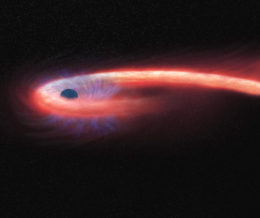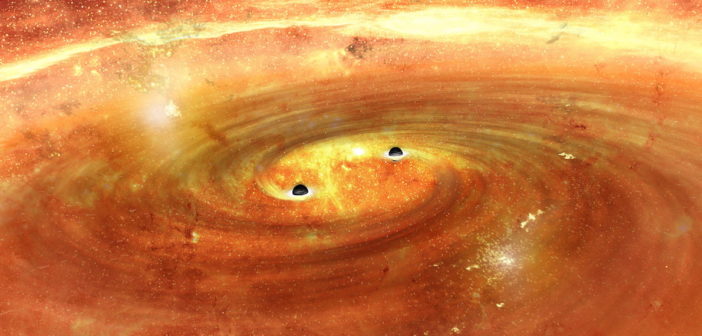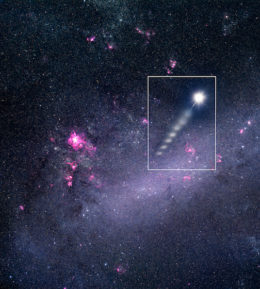You might think that a passing star getting ripped apart by a supermassive black hole sounds like more than enough drama. But a new study takes this picture a step further, exploring what happens when a stellar binary interacts with a pair of supermassive black holes.
Stellar Destruction

Illustration of a tidal disruption event, in which a star is torn apart by a black hole’s gravitational forces and its material falls onto the black hole. [NASA/CXC/M. Weiss]
But this simple model can’t adequately explain all of the disruption-like signals we’ve observed. Could more complex interactions be at play too? Two clues support this possibility:
- A large fraction of stars exist in binary pairs.
- Supermassive black holes can also form binaries, when their host galaxies merge.
With this in mind, a team of scientists led by Eric Coughlin (an Einstein Postdoctoral Fellow at UC Berkeley at the time) has explored a more complicated tidal disruption scenario: that in which a stellar binary interacts with a supermassive black-hole binary.
Simulating Paired Encounters

In some of the authors’ simulated encounters, both stars are tidally disrupted, but with a delay between the two disruptions. This plot shows the distribution of times (measured in number of orbits of the black holes) for the delay between the two disruptions. [Adapted from Coughlin et al. 2018]
Most encounters result either in the entire intact stellar binary being ejected from the system, or in the two stars being ejected one after the other, after the stellar binary is broken up. But several more interesting outcomes are also possible:
- Hills capture, in which one star is ejected and the other is captured into orbit around one of the black holes.
- Single and double TDEs, in which either one or both stars are torn apart and their material accretes onto the black-hole binary.
- Stellar mergers, in which the two stars lose angular momentum and merge with each other as a result of interacting with and being ejected by the black-hole binary.
Telltale Signals
Coughlin and collaborators point out that these exotic possibilities are interesting because they create distinctive signals — some of which are consistent with signals that we’ve observed, and some of which we can hope to look for in the future.
A double TDE, for instance, could nicely account for the very bright, double-peaked transient known as ASASSN-15lh. The accelerated inspiral of a stellar binary — after having been flung from its galaxy by the supermassive black-hole binary — could account for some calcium-rich transient signals we’ve spotted. And two members of a stellar binary, individually ejected from a galaxy, may later be detectable as hypervelocity stars that have similar spectroscopic properties despite being thousands of light-years apart.The intriguingly broad range of outcomes that result from the meeting of stellar and black-hole binaries demonstrates that these possibilities are worth exploring further. It would seem that in some cases, this extra drama may be just what we’ve been missing.
Bonus
Check out the video below, which shows just one of the authors’ many simulation results. In this case, the interactions between the stellar and black-hole pairs breaks up the stellar binary. One of the stars is ejected from the system, and the other is captured around one of the black holes.
Citation
“Stellar Binaries Incident on Supermassive Black Hole Binaries: Implications for Double Tidal Disruption Events, Calcium-rich Transients, and Hypervelocity Stars,” Eric R. Coughlin et al 2018 ApJL 863 L24. doi:10.3847/2041-8213/aad7bd


2 Comments
Pingback: AAS Nova – New
Pingback: Daily Study Log (2019-02-07) | Study Astrophysics